How to Detect Breast cancer in Early stages
Bosom disease (the uncontrolled development of strange cells in the bosom) is one of the most widely recognized malignant growth types in the United States. Early recognition is key in the therapy of bosom disease. There are steps you can take to recognize bosom malignant growth when it is generally treatable.
Suggested Screening Guidelines
Recommended Screening Guidelines
Mammography. The main evaluating test for bosom malignant growth is the mammogram. A mammogram resembles a X-beam of the bosom. It can identify bosom disease as long as two years before the growth can be felt by you or your PCP.
Informed dynamic beginning at age 40. People ought to talk with their medical services supplier about the advantages of screening and when to begin.Best Breast Cancer surgeon in Delhi
Routine screenings beginning at age 45 to 50. Routine screening consistently or like clockwork is suggested for up to an individual is healthy. Examining your singular gamble with your medical services supplier can assist with deciding how often you ought to be screened.
Bosom disease can influence individuals of all sexual orientations, including men. Driving associations additionally have various suggestions for when and how frequently to be screened. It is critical to talk with your PCP to more deeply study your gamble and their ideas for screening.
Some Risk Factors for Breast Cancer
Coming up next are a portion of the realized gamble factors for bosom malignant growth. Notwithstanding, most instances of bosom malignant growth can't be connected to a particular reason. Converse with your primary care physician about your particular gamble.
Age. The possibility getting bosom malignant growth increments with age. Almost 80% of bosom malignant growths are tracked down in those beyond 50 years old.
Individual history of bosom malignant growth. A person who has had bosom malignant growth in one bosom is at an expanded gamble of creating disease in the other bosom.
Family background of bosom malignant growth. A higher gamble of bosom malignant growth is related with having a close relative with bosom disease, particularly early on (before 40). Having different family members with bosom malignant growth may likewise raise the gamble.
Hereditary elements. Certain hereditary transformations, including changes to the BRCA1 and BRCA2 qualities, are related with a higher gamble of creating bosom malignant growth eventually. Other quality changes might raise bosom disease risk too. For more data, get some information about extensive biomarker testing, which might incorporate hereditary testing for acquired disease risk.
Childbearing and feminine history. Research recommends a connection among conceptive and feminine history and the gamble of bosom malignant growth. Higher gamble factors include:
Breast Cancer Signs and Symptoms
Any of the accompanying side effects ought to be looked at by your PCP. They could happen for various reasons including bosom disease or non-dangerous circumstances. It is in every case best to report any progressions to decide the causes.
Protuberance or mass
Change in size or state of the bosom or areola
Change in variety to bosom or areola
Modified areola
Areola release
Enlarging or thickening of the bosom
Steady agony
Dimpling of the skin
Flakiness or disturbed skin


Comments
Post a Comment